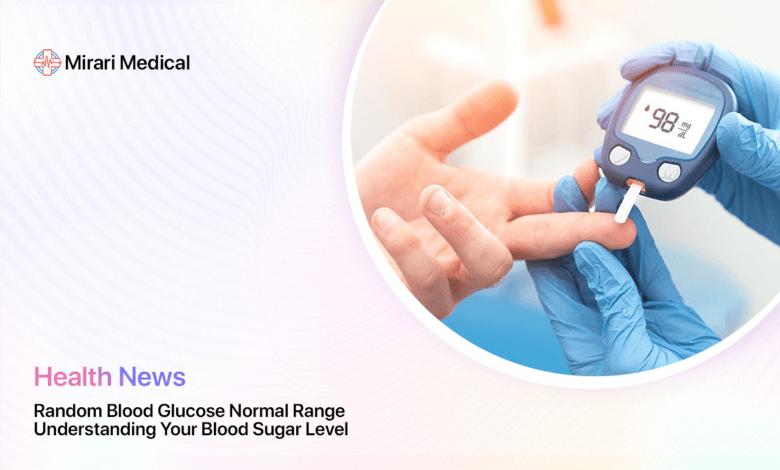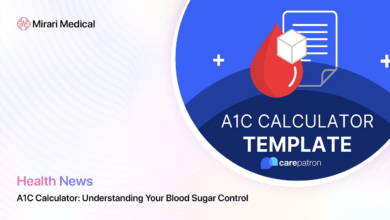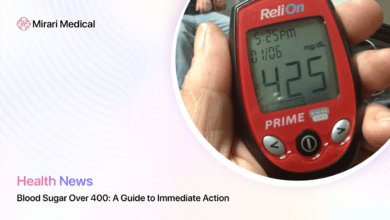Random Blood Glucose Testing: Normal Levels and What They Mean

You may be interested
Did you know that over 37 million Americans have diabetes, and 1 in 5 of them don’t even know they have it? Random blood glucose testing is a powerful tool for diagnosing diabetes and monitoring blood sugar control, but understanding what the numbers mean can be confusing. In this comprehensive guide, we’ll dive into the science behind random blood glucose testing, explore normal blood glucose ranges for various populations, and discuss the implications of high or low results. Whether you’re living with diabetes or simply curious about your health, this article will empower you with the knowledge you need to take control of your blood sugar.
Understanding Random Blood Glucose Testing
What is a Random Blood Glucose Test?
A random blood glucose (RBG) test, also known as a casual blood glucose test, measures the amount of glucose (sugar) in your blood at any given moment, regardless of when you last ate. This test is different from a fasting blood glucose (FBG) test, which requires you to fast for at least 8 hours before the blood sample is taken. The RBG test is a quick and convenient way for healthcare providers to screen for diabetes and assess blood sugar control in people with known diabetes.
Why is a Random Blood Glucose Test Performed?
There are several reasons why your healthcare provider may order a random blood glucose test:
- To screen for diabetes in people with symptoms such as increased thirst, frequent urination, blurred vision, or unexplained weight loss
- To diagnose diabetes in emergency situations, such as when a person is experiencing severe symptoms or complications
- To monitor blood sugar control in people with known diabetes, especially if they are experiencing symptoms of high or low blood sugar
- To assess the effectiveness of diabetes treatment plans and make adjustments as needed
How is a Random Blood Glucose Test Performed?
A random blood glucose test is a simple procedure that can be done in a healthcare provider’s office or clinic. The steps typically include:
- A healthcare professional will clean your finger with an alcohol swab.
- They will then prick your finger with a small lancet to obtain a drop of blood.
- The blood sample is placed on a test strip and inserted into a glucose meter.
- The meter will display your blood glucose level in either milligrams per deciliter (mg/dL) or millimoles per liter (mmol/L).
The entire process usually takes less than 5 minutes and does not require any special preparation or fasting.
Normal Blood Glucose Ranges
Normal Blood Glucose Ranges for Adults Without Diabetes
For people without diabetes, normal blood glucose levels typically fall within the following ranges:
- Fasting blood glucose: 70-99 mg/dL (3.9-5.5 mmol/L)
- Random blood glucose: less than 140 mg/dL (7.8 mmol/L)
These ranges are based on guidelines from the American Diabetes Association and represent the expected blood sugar levels for healthy individuals.
Normal Blood Glucose Ranges for Adults with Diabetes
For adults with diabetes, target blood glucose ranges may be slightly higher than those for people without diabetes. The American Diabetes Association recommends the following targets:
- Before meals (fasting): 80-130 mg/dL (4.4-7.2 mmol/L)
- 1-2 hours after meals: less than 180 mg/dL (10.0 mmol/L)
However, individual targets may vary based on factors such as age, duration of diabetes, and presence of complications. It’s important to work closely with your healthcare provider to determine the right goals for you.
Normal Blood Glucose Ranges for Children with Type 1 Diabetes
Children with type 1 diabetes have unique blood sugar needs and may require different target ranges than adults. The International Society for Pediatric and Adolescent Diabetes recommends the following targets:
- Before meals: 70-130 mg/dL (3.9-7.2 mmol/L)
- Bedtime/overnight: 80-140 mg/dL (4.4-7.8 mmol/L)
Maintaining tight blood sugar control is especially important for children with diabetes to promote healthy growth and development and reduce the risk of long-term complications.
Normal Blood Glucose Ranges for Pregnant Women with Diabetes
Pregnancy can complicate blood sugar management for women with pre-existing diabetes or those who develop gestational diabetes. Tight blood glucose control is crucial for protecting the health of both mother and baby. The American Diabetes Association recommends the following targets for pregnant women with diabetes:
- Before meals (fasting): 95 mg/dL (5.3 mmol/L) or less
- 1 hour after meals: 140 mg/dL (7.8 mmol/L) or less
- 2 hours after meals: 120 mg/dL (6.7 mmol/L) or less
Regular blood glucose monitoring and close collaboration with a healthcare team are essential for achieving these targets and ensuring a healthy pregnancy.
Normal Blood Glucose Ranges for People with Gestational Diabetes
Gestational diabetes is a type of diabetes that develops during pregnancy in women who don’t already have diabetes. Blood sugar targets for women with gestational diabetes are typically lower than those for non-pregnant individuals:
- Fasting: 95 mg/dL (5.3 mmol/L) or less
- 1 hour after meals: 140 mg/dL (7.8 mmol/L) or less
- 2 hours after meals: 120 mg/dL (6.7 mmol/L) or less
Meeting these targets through a combination of diet, exercise, and medication (if needed) can help reduce the risk of complications for both mother and baby.
Interpreting Random Blood Glucose Test Results
What Does a High Random Blood Glucose Level Mean?
A random blood glucose level of 200 mg/dL (11.1 mmol/L) or higher, along with symptoms of diabetes, is often enough to diagnose diabetes. However, a single high result doesn’t necessarily mean you have diabetes. Your healthcare provider may order additional tests, such as a fasting blood glucose test or an A1C test, to confirm the diagnosis.
High random blood glucose levels can also occur in people with known diabetes, indicating that their blood sugar is not well-controlled. This may require adjustments to their treatment plan, such as changes in medication, diet, or physical activity.
What Does a Low Random Blood Glucose Level Mean?
Low blood glucose, or hypoglycemia, is defined as a blood sugar level below 70 mg/dL (3.9 mmol/L). Symptoms of low blood sugar may include shakiness, sweating, confusion, and dizziness. Low random blood glucose levels are most common in people with diabetes who take insulin or certain other diabetes medications.
In people without diabetes, low random blood glucose levels are relatively rare but can occur due to factors such as liver disease, kidney disorders, or tumors that produce excess insulin. If you experience symptoms of low blood sugar or have consistently low random blood glucose levels, it’s important to speak with your healthcare provider to determine the underlying cause and appropriate treatment.
Factors that Can Affect Random Blood Glucose Levels
Several factors can influence your random blood glucose levels, including:
- Food and drink: Consuming carbohydrate-rich foods or sugary beverages can cause a temporary spike in blood sugar.
- Physical activity: Exercise can help lower blood sugar levels by increasing insulin sensitivity and promoting glucose uptake by muscles.
- Stress: Hormones released during stress can cause blood sugar levels to rise.
- Medications: Some medications, such as steroids or antipsychotics, can increase blood sugar levels.
- Illness: Infections and other illnesses can trigger the release of stress hormones, leading to higher blood sugar levels.
Understanding these factors can help you interpret your random blood glucose results and make informed decisions about your health.
Prediabetes and Diabetes
Prediabetes: Understanding the Risk
Prediabetes is a condition in which blood sugar levels are higher than normal but not high enough to be diagnosed as diabetes. A random blood glucose level between 140-199 mg/dL (7.8-11.0 mmol/L) may indicate prediabetes.
People with prediabetes are at increased risk of developing type 2 diabetes, heart disease, and stroke. However, lifestyle changes such as losing weight, eating a healthy diet, and increasing physical activity can help prevent or delay the progression to type 2 diabetes.
Diabetes: Diagnosis and Management
Diabetes is a chronic condition characterized by high blood sugar levels. The two main types of diabetes are type 1 diabetes, in which the body doesn’t produce insulin, and type 2 diabetes, in which the body doesn’t use insulin properly.
A random blood glucose level of 200 mg/dL (11.1 mmol/L) or higher, along with symptoms of diabetes, is sufficient for a diabetes diagnosis. Once diagnosed, diabetes management typically involves a combination of lifestyle modifications, blood sugar monitoring, and medication (if needed).
Lifestyle Modifications for Prediabetes and Diabetes
Whether you have prediabetes or diabetes, making healthy lifestyle choices is crucial for managing your blood sugar and reducing your risk of complications. Some key lifestyle modifications include:
- Eating a balanced diet rich in fruits, vegetables, whole grains, and lean proteins
- Engaging in regular physical activity, aiming for at least 150 minutes of moderate-intensity exercise per week
- Maintaining a healthy weight or losing weight if overweight or obese
- Managing stress through techniques such as deep breathing, meditation, or yoga
- Getting adequate sleep, aiming for 7-9 hours per night
Working closely with your healthcare team can help you develop a personalized plan for incorporating these lifestyle changes and managing your blood sugar effectively.
The Importance of Blood Glucose Control
Long-Term Complications of Uncontrolled Blood Glucose
Consistently high blood sugar levels can lead to serious long-term complications, including:
- Cardiovascular disease: High blood sugar can damage blood vessels and nerves, increasing the risk of heart attack, stroke, and peripheral artery disease.
- Kidney damage (nephropathy): Diabetes is a leading cause of kidney failure, as high blood sugar can damage the tiny blood vessels in the kidneys.
- Eye damage (retinopathy): High blood sugar can damage the blood vessels in the retina, potentially leading to vision loss or blindness.
- Nerve damage (neuropathy): Elevated blood sugar levels can cause damage to nerves throughout the body, leading to numbness, tingling, pain, or weakness.
Maintaining good blood glucose control through lifestyle modifications and appropriate medical treatment can help reduce the risk of these complications.
Benefits of Maintaining Healthy Blood Glucose Levels
Keeping your blood glucose levels within a healthy range offers numerous benefits, including:
- Reduced risk of diabetes-related complications
- Improved energy levels and overall well-being
- Better weight management
- Enhanced immune function and wound healing
- Improved mental health and cognitive function
By prioritizing blood sugar control, you can take an active role in promoting your long-term health and quality of life.
Resources for Diabetes Management
Managing diabetes can be challenging, but numerous resources are available to support you on your journey:
- American Diabetes Association (ADA): The ADA offers a wealth of information, resources, and support for people with diabetes, including educational materials, local events, and online communities.
- National Institute of Diabetes and Digestive and Kidney Diseases (NIDDK): The NIDDK provides comprehensive information about diabetes prevention, management, and research.
- Diabetes Self-Management Education and Support (DSMES): DSMES programs offer personalized education and support to help people with diabetes develop the knowledge, skills, and confidence to manage their condition effectively.
- Continuous Glucose Monitoring (CGM) devices: CGM systems provide real-time blood sugar data, helping people with diabetes make informed decisions about their care.
Don’t hesitate to reach out to your healthcare team or explore these resources for guidance and support in managing your diabetes.
Takeaways
- Random blood glucose testing is a quick and convenient way to screen for diabetes and monitor blood sugar control in people with known diabetes.
- Normal random blood glucose levels are typically less than 140 mg/dL (7.8 mmol/L) for people without diabetes, while target ranges for those with diabetes may be slightly higher and individualized based on factors such as age and overall health.
- High random blood glucose levels (200 mg/dL or 11.1 mmol/L and above) may indicate diabetes, while low levels (below 70 mg/dL or 3.9 mmol/L) can occur in people with diabetes who take certain medications or have other underlying health conditions.
- Prediabetes is a condition in which blood sugar levels are higher than normal but not high enough to be diagnosed as diabetes, and it increases the risk of developing type 2 diabetes, heart disease, and stroke.
- Lifestyle modifications, such as eating a balanced diet, engaging in regular physical activity, and managing stress, are crucial for managing blood sugar levels and reducing the risk of diabetes-related complications.
- Numerous resources, including the American Diabetes Association, National Institute of Diabetes and Digestive and Kidney Diseases, and Diabetes Self-Management Education and Support programs, are available to support people in managing their diabetes effectively.
By understanding the importance of random blood glucose testing and the factors that influence blood sugar levels, you can take an active role in promoting your health and well-being. Remember, knowledge is power, and by staying informed and working closely with your healthcare team, you can successfully navigate the challenges of diabetes management and enjoy a high quality of life.
Your trusted source for health info, offering expert advice, news, and tips to stay healthy and informed.





